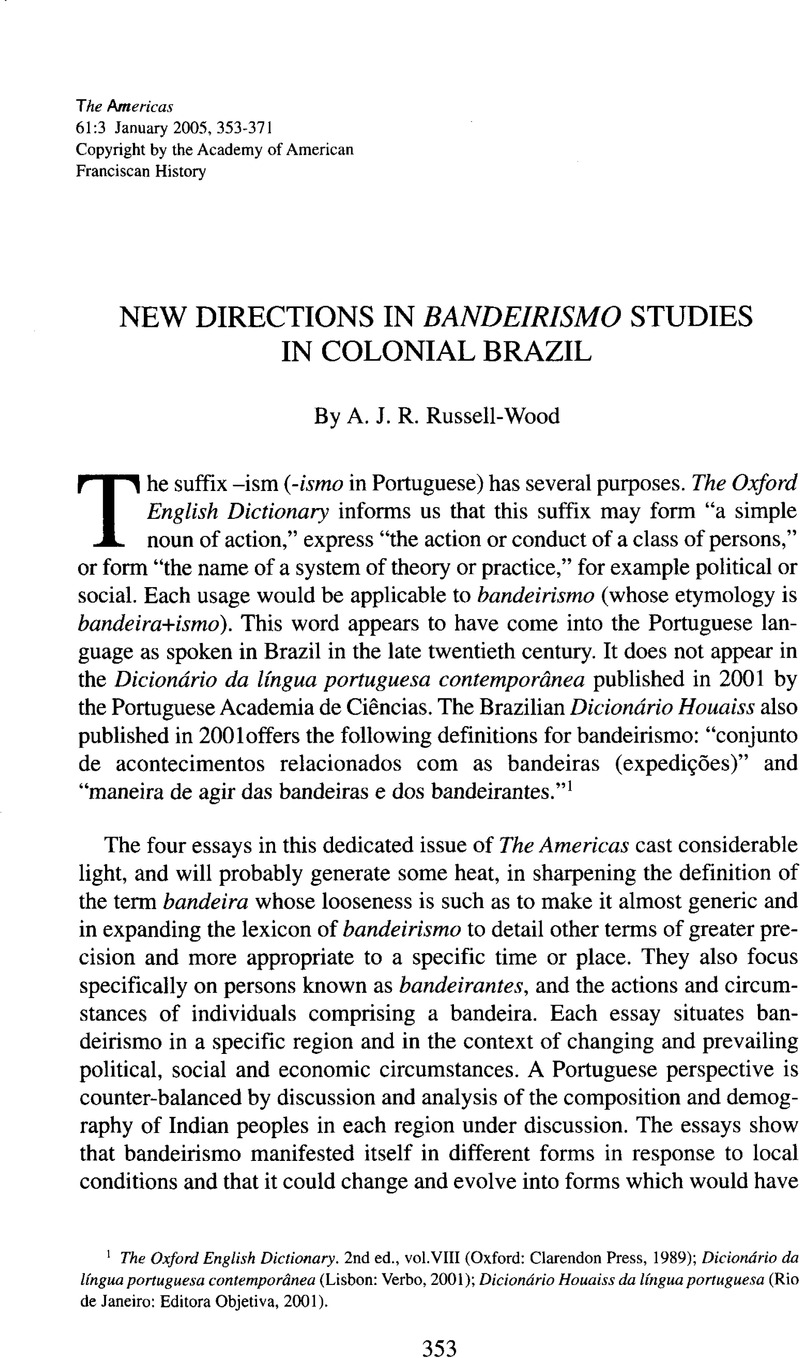Published online by Cambridge University Press: 11 December 2015

1 The Oxford English Dictionary. 2nd ed., vol.VIII (Oxford: Clarendon Press, 1989); Dicionário da língua portuguesa contemporânea (Lisbon: Verbo, 2001); Dicionário Houaiss da lingua portuguesa (Rio de Janeiro: Editora Objetiva, 2001).
2 Hemming, John, Red Gold. The Conquest of the Brazilian Indians, 1600–1760 (Cambridge, Mass: Harvard University Press, 1978), pp. 487–501.Google Scholar
3 Hemming, , Red Gold and Amazon Frontier. The Defeat of the Brazilian Indians (Cambridge, Mass: Harvard University Press, 1987).Google Scholar
4 Saunders, A.C. de C.M., A Social History of Black Slaves and Freedmen in Portugal, 1441–1555 (Cambridge: Cambridge University Press, 1982);Google Scholar Russell-Wood, A.J.R., “Before Columbus: Portugal's African Prelude to the Middle Passage and Contribution to Discourse on Race and Slavery,” in Race, Discourse, and the Origin of the Americas. A New World View, edited by Hyatt, Vera L. and Nettleford, Rex (Washington and London: Smithsonian Institution Press, 1995), pp. 134–68.Google Scholar
5 Boxer, C. R., The Golden Age of Brazil, 1695–1750. Growing Pains of a Colonial Society (Berkeley and Los Angeles: University of California Press, 1962), pp. 290–291.CrossRefGoogle Scholar
6 Boxer, ,Golden Age, pp. 300–01.Google Scholar
7 Russell-Wood, A.J.R., Um Mundo em Movimento. Os Portugueses na África, Asia, e América, 1415–1808 (Lisbon: Editora Difel, 1998), p. 131.Google Scholar
8 Monteiro, John Manuel, Negros da terra. Índios e bandeirantes nas origins de São Paulo (São Paulo: Companhia de Letras, 1994);Google Scholar da Cunha, Manuela Carneiro, ed., História dos Índios no Brasil (São Paulo: Companhia das Letras, 1992);Google Scholar de Almeida, Rita Heloísa, O Diretório dos Índios: Um projeto de civilização no Brasil no século XVIII (Brasília: Editora Universidade de Brasília, 1997);Google Scholar Giraldin, Odair, Cayapó e Panará: Luta e sobrevivência de um povo Jê no Brasil Central (Campinas, São Paulo: Editora da UNICAMP, 1997);Google Scholar Domingues, Angela, Quando os Índios eram vassalos: colonização e relações de poder no Brasil na segunda metade do século XVIII (Lisbon: Comissão Nacional para as Comemorações dos Descobrimentos Portugueses, 2000);Google Scholar Wojtalewicz, Paul David, “The ‘Junta de Missões’: The Missions in the Amazon Basin” (M.A. thesis: University of Minnesota, 1993);Google Scholar de Alencastro, Luiz Felipe, O Trato dos Viventes. Formação do Brasil no Atlântico Sul. Séculos XVI e XVIII (São Paulo: Companhia das Letras, 2000);Google Scholar Metcalf, Alida, Go-Betweens and the Conquest of Brazil (Austin, University of Texas Press)Google Scholar and Langfur, Hal, The Forbidden Lands: Frontier Violence, Colonial Identity, and the Persistence of Brazil's Eastern Indians, 1750–1834 (Stanford: Stanford University Press).CrossRefGoogle Scholar
9 Morse, Richard, ed., The Bandeirantes. The Historical Role of the Brazilian Pathfinders (New York: Alfred A. Knopf, 1965).Google Scholar